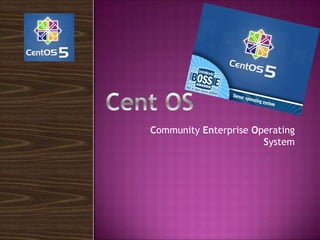
Centos1
- 1. Community Enterprise Operating System Cent OS
- 2. Cent OS which stands for Community Enterprise Operating System, is the result of a group of open source contributors and users working together to develop Linux solutions that are freely available to users who do not require a great deal of commercial support to achieve their goal
- 3. CentOS dedicated servers were designed based on Red Hat's product, Red Hat Enterprise Linux. Although the Red Hat Linux server is made entirely of free and open source software, it is only distributed to the public in binary form (including CD-ROM and DVD-ROM) at a fee paid by subscribers. However, Red Hat does release its source code for its product under the terms of the GNU General Public License.
- 4. So the use of the code for the creation of the CentOS Linux distribution is an entirely valid and acceptable practice. The distribution of CentOS products completely complies with Red Hat's redistribution policy. The CentOS server is almost identical to the Red Hat product except that it is modified to remove all Red Hat branding and artwork. CentOS and its Linux solutions are not in any way affiliated with or supported by Red Hat, Inc.
- 5. Structure Red Hat Enterprise Linux is available only through a paid subscription service that provides access to software updates and varying levels of technical support. The product is largely composed of software packages distributed under open source licenses, and the source code for these packages is made public by Red Hat.
- 6. CentOS developers use Red Hat's source code to create a final product very similar to Red Hat Enterprise Linux. Red Hat's branding and logos are changed because Red Hat does not allow them to be redistributed
- 7. CentOS is available free of charge. Technical support is primarily provided by the community via official mailing lists, web forums, and chat rooms. The project is not affiliated with Red Hat and thus receives no financial or logistical support from the company; instead, the CentOS Project relies on donations from users and organizational sponsors.
- 8. The Goals of CentOS The CentOS dedicated Linux servers and distributions are developed by a team of core developers who are supported by a user community comprised of system administrators, network administrators, enterprise users, managers, core Linux contributors, and Linux enthusiasts all over the world.
- 9. CentOS products were designed with the goal of providing organizations and individuals with Linux products to help them achieve success in activities like dedicated Linux server hosting and dedicated server web hosting. In an effort to meet this goal, CentOS is committed to:
- 10. Creating solutions that are easily maintained. Usable for the long-term in production environments. A user and package maintainer friendly environment. Supporting the core for the long-term. Actively working toward the development of additional solutions. A strong community infrastructure. An open management policy. An open business model. Commercial support through its partner vendors, like Vault Networks.
- 11. Versioning scheme CentOS version numbers have two parts, a major version and a minor version. The major and minor version numbers respectively correspond to the major version and update set of Red Hat Enterprise Linux from which the source packages used to build CentOS are taken. For example, CentOS 4.4 is built from the source packages from Red Hat Enterprise Linux 4 update 4.
- 12. Since mid-2006, starting with version 4.4 (formerly known as Red Hat Enterprise Linux 4.0 update 4), Red Hat has adopted a versioning convention identical to that of CentOS, e.g., Red Hat Enterprise Linux 4.5
- 13. Architectures CentOS supports the x86 architectures: x86 (32-bit) x86-64 (AMD's AMD64 and Intel's EM64T, 64-bit) The following architectures were supported by CentOS up to version 4: IA-64 (Intel Itanium architecture, 64-bit) (beta support since CentOS 3) PowerPC/32 (AppleMacintosh and PowerMac running the G3 or G4 PowerPC processor) (beta support since CentOS 3) IBMMainframe (eServerzSeries and S/390) (not CentOS 5)
- 14. The following two architectures were supported or partially supported in CentOS but are not supported upstream: Alpha (CentOS 4 only) SPARC (beta support since CentOS 3)
- 15. Bootable media version A Live CD version of CentOS is available at mirror.centos.org. A Live USB of CentOS can be created manually or with UNetbootin.
- 16. Tao Linux Tao Linux was another prominent distribution derived from Red Hat Enterprise Linux. Its primary developer announced in June 2006 that Tao would be retired and rolled into CentOS development. Migration via 'yum update' was available to Tao users, providing a relatively painless migration path to the CentOS release. This helped prevent Tao users from becoming "orphaned" by their OS.
- 17. Organizational difficulties In July of 2009, it was reported that CentOS's founder, Lance Davis, had disappeared in 2008. Davis had ceased contribution to the project but continued to hold the registration for the CentOS domain and PayPal account. In August of 2009, the CentOS team reportedly made contact with Davis and obtained the centos.info and centos.org domains.
